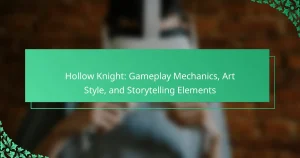Hollow Knight captivates players with its rich lore, intricate boss encounters, and immersive world-building. The game’s narrative explores themes of sacrifice and isolation while showcasing the conflict between the Radiance and the Pale King. Players experience interconnected environments that enhance exploration and emotional engagement. Unique boss designs and mechanics reflect the history of Hallownest, deepening the overall gameplay experience.
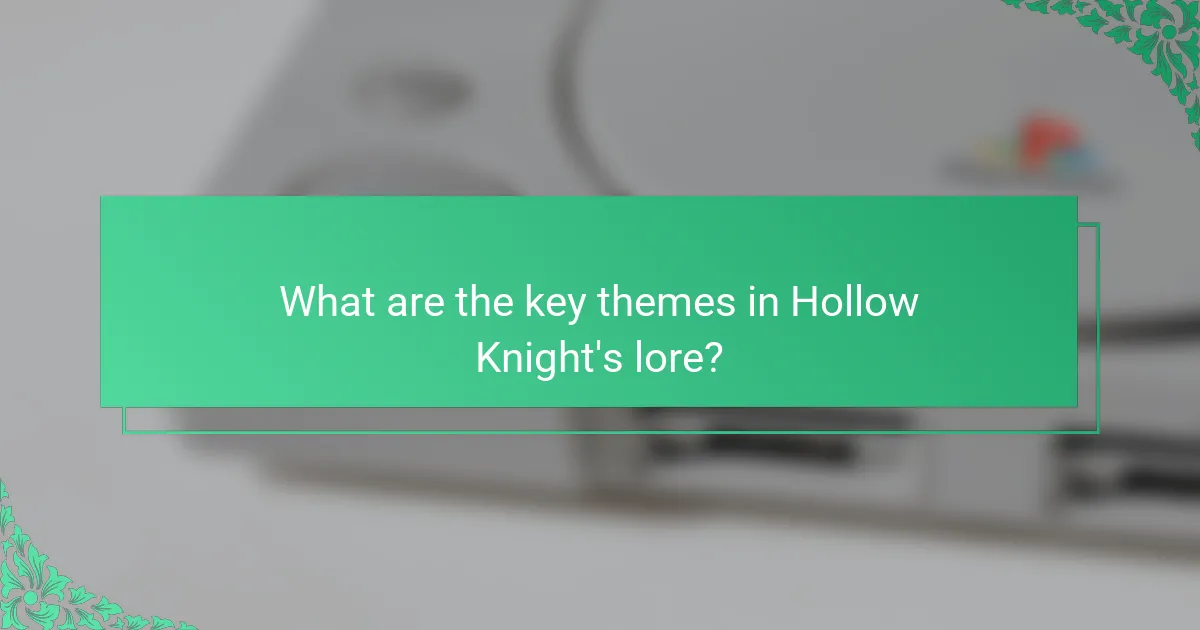
What are the key themes in Hollow Knight’s lore?
Hollow Knight’s lore explores themes of sacrifice, isolation, and the cyclical nature of life and death. The conflict between the Radiance and the Pale King highlights the struggle for control over Hallownest. The concept of dreams and their impact on reality adds depth to character motivations. Additionally, the lore emphasizes the consequences of ambition and the fragility of memory.
How do the themes of sacrifice and redemption manifest in the game?
In “Hollow Knight,” themes of sacrifice and redemption are central to the narrative. Characters like the Knight and Hornet embody sacrifice, facing personal loss to protect their world. The game explores redemption through the character arc of the Hollow Knight, who seeks to atone for past mistakes. This interplay drives the emotional depth of the lore and enhances player engagement with the world-building. The sacrifices made by characters often lead to moments of redemption, creating a rich tapestry of interconnected stories and motivations.
What role does the concept of the Void play in the narrative?
The concept of the Void serves as a central theme in Hollow Knight, symbolising emptiness and the unknown. It influences the narrative by shaping the lore surrounding the Radiance and the infection. The Void is associated with the game’s unique entities, such as the Hollow Knight and the Void creatures, which embody the struggle against despair. As players explore Hallownest, the Void’s presence deepens the world-building, creating a haunting atmosphere that reflects themes of loss and identity.
Which characters embody the game’s central themes?
The characters in Hollow Knight embody themes of sacrifice, loss, and the cyclical nature of life. The Knight represents resilience and the struggle against darkness, while Hornet embodies the conflict between duty and personal desire. The Pale King symbolizes the burden of leadership and the consequences of ambition. Each character’s journey reflects the game’s deep lore and interconnected narratives, illustrating how personal sacrifices shape their destinies.
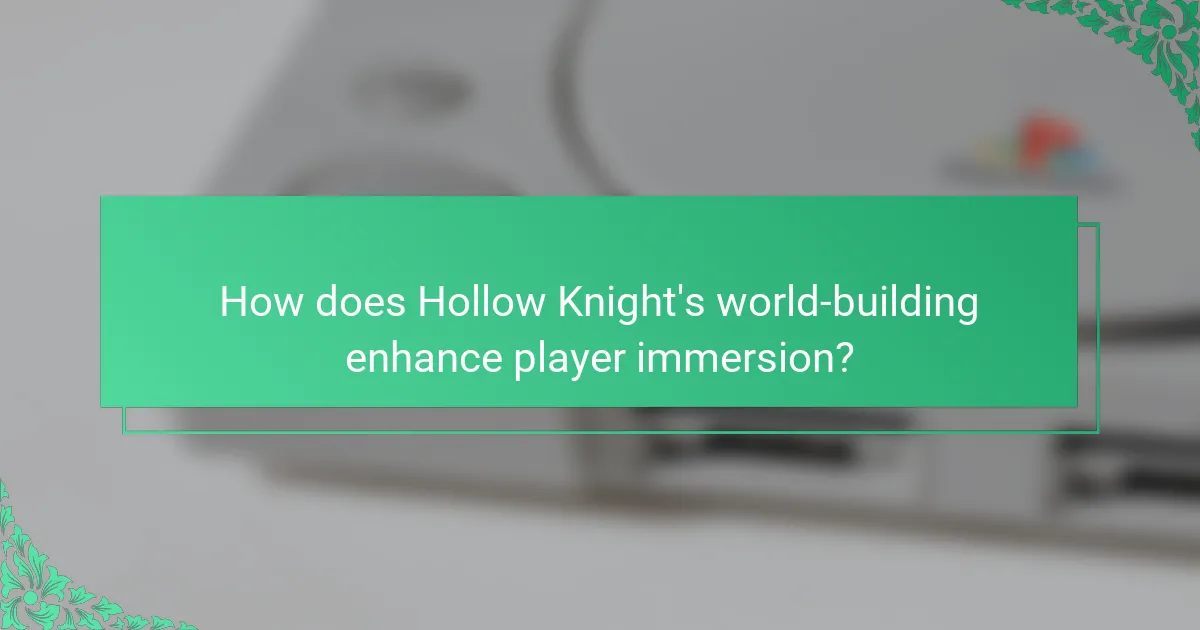
How does Hollow Knight’s world-building enhance player immersion?
Hollow Knight’s world-building significantly enhances player immersion through its intricate lore, atmospheric design, and interconnected environments. The game’s setting, Hallownest, is rich with history, providing players with a sense of discovery and depth. Each area features unique aesthetics and challenges, immersing players in the narrative and encouraging exploration.
The lore is conveyed through environmental storytelling, NPC interactions, and item descriptions, creating a cohesive narrative that unfolds gradually. Boss encounters are tied to the world, reflecting its themes and history, which deepens emotional engagement.
Furthermore, the game’s art style and sound design complement the world-building, evoking a haunting yet beautiful atmosphere. This combination of factors fosters a strong connection between players and the game’s universe, making exploration feel rewarding and meaningful.
What are the distinctive regions within Hallownest and their significance?
Hallownest features distinctive regions that contribute to its lore and gameplay. Each area has unique characteristics, enemies, and lore significance.
The Forgotten Crossroads serves as a central hub, linking various regions and introducing players to the game’s mechanics. The Greenpath is notable for its lush environment and challenging enemies, symbolising the beauty and danger of Hallownest. The City of Tears represents the fallen civilization, filled with rich lore and emotional depth. The Crystal Peak showcases intricate platforming and reflects the game’s themes of exploration and discovery.
Each region enhances the player’s experience, offering insights into the history and culture of Hallownest, while also presenting unique challenges and boss encounters.
How do environmental storytelling and design contribute to the lore?
Environmental storytelling and design significantly enhance the lore of Hollow Knight by immersing players in its rich narrative. The game’s world, Hallownest, is intricately designed, with environments that reflect the history and culture of its inhabitants. Each area tells a story through visual elements, such as architecture and environmental details, which reveal past events and character motivations.
The unique attribute of Hollow Knight is its use of subtle cues in the environment to convey lore without explicit exposition. For instance, the remnants of fallen knights and the presence of forgotten relics hint at the tragic history of Hallownest. This approach fosters a deeper emotional connection to the world and its characters.
Additionally, the design of boss encounters often incorporates environmental storytelling. Boss arenas are crafted to reflect their backstories, enhancing the player’s understanding of their motivations. This integration of design and narrative creates a cohesive experience that invites exploration and discovery.
Overall, the combination of environmental storytelling and design in Hollow Knight not only enriches its lore but also encourages players to engage more fully with the game world.
Which artifacts and relics deepen the world’s backstory?
Artifacts and relics in “Hollow Knight” enrich the backstory through their unique narratives and historical significance. Key items include the Dream Nail, which reveals memories, and the King’s Brand, symbolising authority. The Ancient Masks provide insight into the culture of the Pale King’s kingdom. Additionally, the various charms reflect the essence of the inhabitants, deepening the lore. Each artifact contributes to understanding the interconnectedness of characters and events, enhancing the overall world-building.
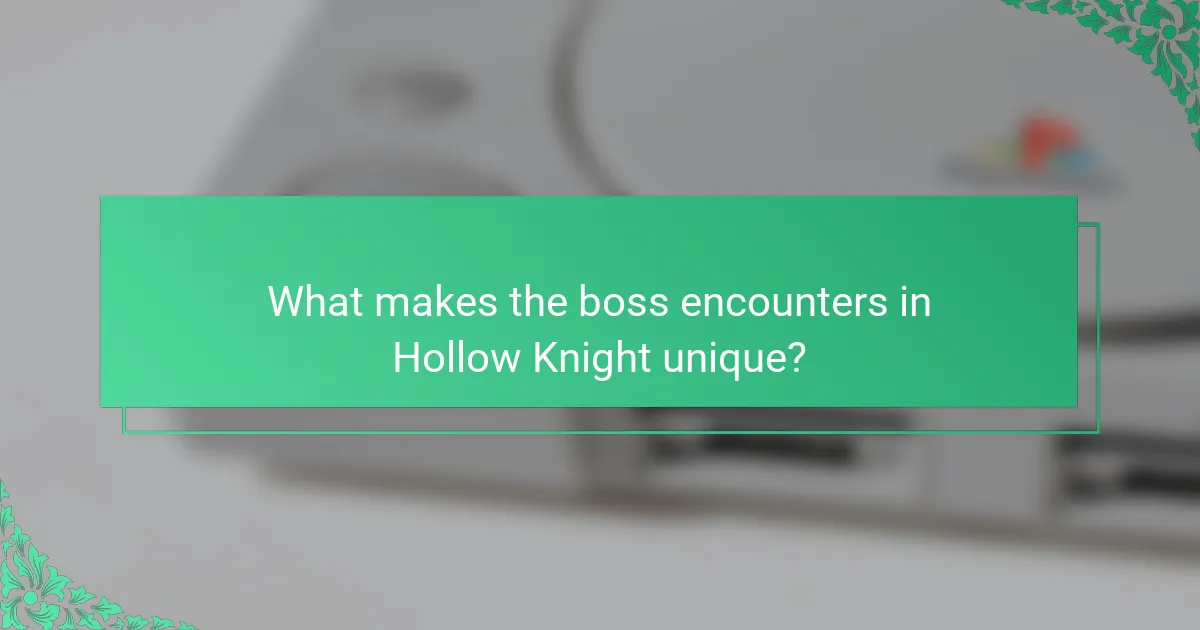
What makes the boss encounters in Hollow Knight unique?
The boss encounters in Hollow Knight are unique due to their intricate designs, diverse mechanics, and deep lore connections. Each boss embodies a distinct aspect of the game’s world, reflecting the history and themes of Hallownest. For example, the varied attack patterns and environmental interactions create a dynamic combat experience. Additionally, the emotional narratives tied to each boss enhance player engagement, making victories feel meaningful. This blend of challenging gameplay and rich storytelling sets Hollow Knight’s boss encounters apart from other games.
How do the mechanics of boss fights reflect their lore?
The mechanics of boss fights in Hollow Knight closely mirror their lore, enhancing the player’s emotional connection. Each boss embodies unique aspects of the game’s narrative, reflecting their backgrounds and the world’s history. For instance, the Hollow Knight represents the burden of duty and sacrifice, with combat mechanics emphasizing endurance and resilience. In contrast, the Radiance showcases themes of light and darkness, employing fast-paced attacks that symbolize its overwhelming power. These mechanics not only challenge players but also deepen their understanding of the lore, creating a cohesive experience that intertwines gameplay and storytelling.
Which bosses are considered pivotal to the game’s narrative?
The pivotal bosses in “Hollow Knight” include the Hollow Knight, Radiance, and the Dreamers. Each boss significantly influences the game’s narrative and themes. The Hollow Knight represents the burden of duty and sacrifice, while Radiance embodies the struggle against the infection. The Dreamers, including Monomon, Lurien, and Herrah, provide essential backstory and context to the game’s lore. Their encounters deepen the player’s understanding of Hallownest’s tragic history and the consequences of choices made by its inhabitants.
What strategies can players employ to defeat challenging bosses?
Players can employ various strategies to defeat challenging bosses in Hollow Knight. Mastering enemy patterns is crucial; observing attacks helps identify openings. Upgrading abilities and charms enhances combat effectiveness. Utilizing the environment for dodging and positioning provides tactical advantages. Timing healing during safe moments can turn the tide in prolonged battles.
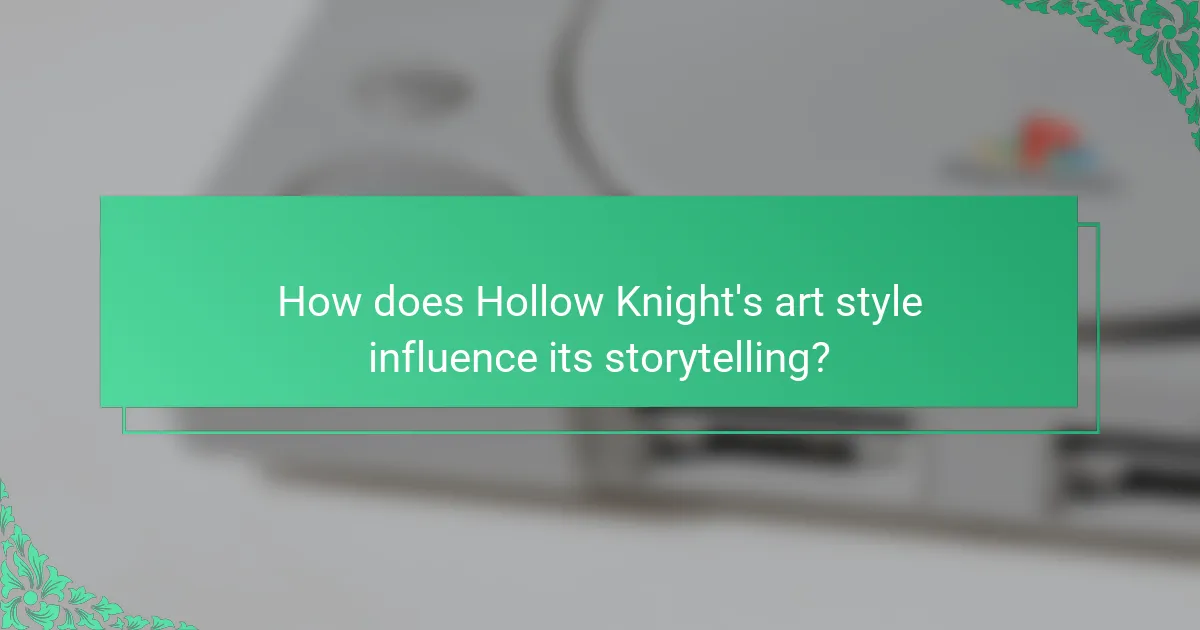
How does Hollow Knight’s art style influence its storytelling?
Hollow Knight’s art style profoundly enhances its storytelling by creating an immersive atmosphere. The hand-drawn visuals evoke a sense of melancholy and mystery, reflecting the game’s themes of loss and exploration. The intricate designs of the environments and characters convey lore without explicit dialogue, allowing players to piece together the narrative through visual cues. For example, the haunting beauty of the Forgotten Crossroads contrasts with the desolation of the Kingdom’s ruins, emphasizing the story’s emotional depth. This unique attribute of visual storytelling fosters a deeper connection between players and the game’s world, enriching the overall experience.
In what ways do the visuals enhance the emotional impact of the game?
Visuals in “Hollow Knight” significantly enhance the game’s emotional impact by creating an immersive atmosphere. The hand-drawn art style evokes a sense of nostalgia, while the use of color and light emphasizes mood shifts. For example, dark areas contrast with vibrant environments, deepening player engagement. The visual storytelling complements the lore, allowing players to connect emotionally with the world and its characters. Unique animations during boss encounters heighten tension, making victories feel more rewarding. Overall, the visuals are integral to conveying themes of loss, exploration, and resilience.
How does the character design reflect their backstories?
Character design in “Hollow Knight” intricately reflects backstories through visual elements and thematic symbolism. For example, the Hollow Knight’s pale appearance signifies their role as a vessel, while the distinct features of bosses reveal their tragic histories. The design of characters like Hornet showcases agility and resilience, mirroring her protective nature. Each design choice enhances the narrative, creating a deeper connection between gameplay and lore.
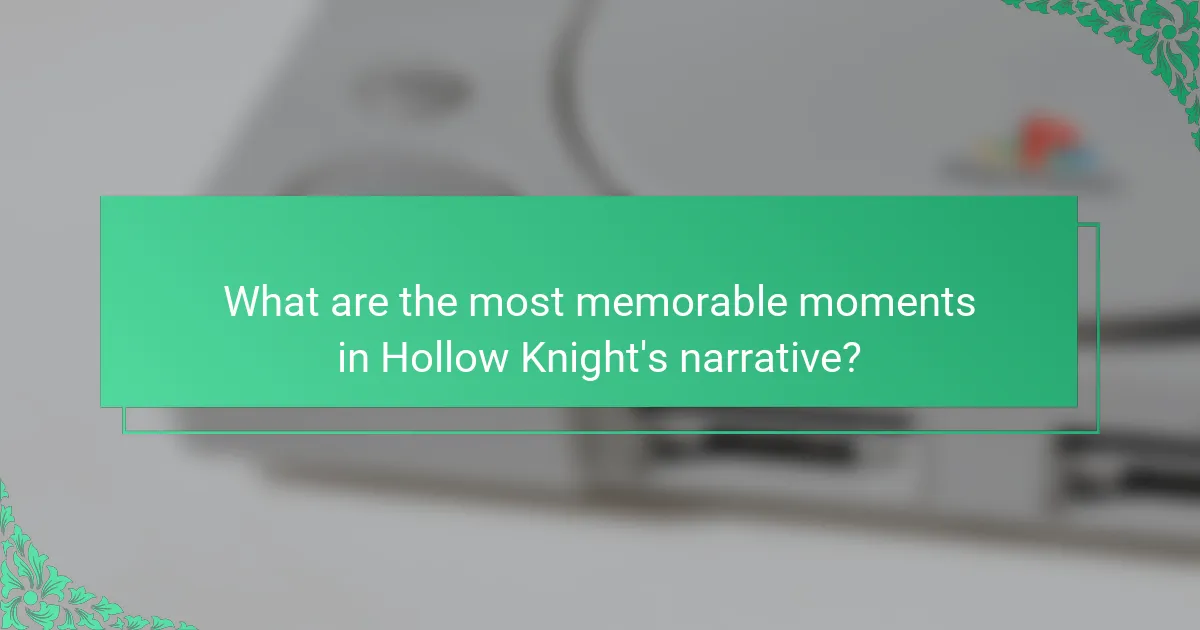
What are the most memorable moments in Hollow Knight’s narrative?
Hollow Knight’s narrative features several memorable moments that shape its emotional depth. Key highlights include the tragic fall of the Pale King, the haunting sacrifice of the Knight, and the poignant encounter with Hornet. These events collectively enhance the game’s themes of loss, sacrifice, and resilience. The unique lore surrounding the Radiance and the infection adds layers to the story, making each boss encounter feel significant. The world-building within Hallownest immerses players in a rich, interconnected narrative filled with rare moments of beauty and despair.
Which plot twists surprised players the most?
The most surprising plot twists in “Hollow Knight” include the revelation of the Knight’s true nature and the fate of the Radiance. Players are often shocked by the interconnectedness of characters and lore, particularly the unexpected ties between the Knight, Hornet, and the Dreamers. The discovery of the true purpose of the Hollow Knight and the implications of the Infection add layers of complexity, leaving players questioning their understanding of the game’s narrative.
How do player choices affect their experience of the story?
Player choices significantly shape their experience of the story in Hollow Knight. The game’s branching paths and multiple endings depend on decisions made throughout the journey. Choices influence character interactions, lore revelations, and the overall atmosphere. For instance, engaging with specific bosses unlocks unique lore elements, enhancing the narrative depth. Additionally, player decisions can lead to different gameplay experiences, affecting difficulty and emotional engagement. Ultimately, these choices create a personalized narrative, making each player’s journey distinct.

What lessons can be learned from Hollow Knight’s design and storytelling?
Hollow Knight’s design and storytelling teach valuable lessons about atmosphere, interconnectedness, and player agency. The game excels in creating a haunting atmosphere through its visual style and sound design. Interconnected world-building enhances exploration, encouraging players to uncover lore organically. The narrative allows for player interpretation, fostering deeper engagement with the story. These elements combined create a rich experience that resonates emotionally with players.
What common mistakes should players avoid to fully appreciate the lore?
Players should avoid common mistakes to fully appreciate Hollow Knight’s lore. Focusing solely on gameplay can lead to missing vital story elements.
Neglecting environmental storytelling diminishes the experience. Each area contains clues about the world and its history. Skipping dialogue with NPCs can result in losing rich backstory and character development.
Rushing through the game prevents players from absorbing the intricate details of the lore. Taking time to explore and reflect enhances understanding. Lastly, overlooking connections between bosses and the world can obscure the narrative’s depth. Engaging with these elements provides a more rewarding experience.
How can players engage with the community to enrich their understanding?
Players can engage with the Hollow Knight community through forums, social media, and fan sites. These platforms facilitate discussions about lore, strategies for boss encounters, and world-building insights. Participating in community events, like fan art contests or lore discussions, enhances understanding and appreciation of the game’s intricate narrative. Additionally, sharing personal experiences and theories fosters a deeper connection among players. Engaging with diverse perspectives can reveal unique attributes of the game, enriching the overall experience.
What best practices can enhance gameplay and narrative appreciation?
To enhance gameplay and narrative appreciation in Hollow Knight, players should focus on exploration, lore immersion, and strategic boss encounters. Engaging deeply with the environment reveals hidden stories and connections. Understanding the lore adds layers to character motivations and world-building. Mastering boss mechanics promotes a rewarding gameplay experience.
